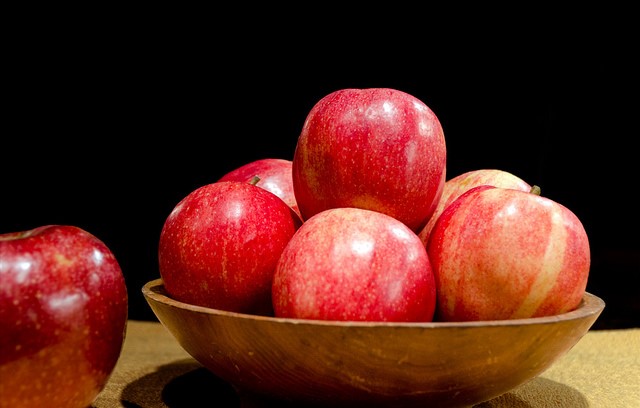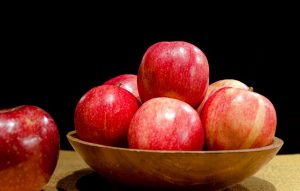
by Dorothy C. Lee | May 25, 2019
Herbs are like people; each herb has its own personality. Some herbs have bold flavors and should be used with care while others are mild and can be used more freely. View Shopping for Health: Herbs and Spices for more about this.
Herbs can be divided into two categories. Accent herbs and herbs that add character to dishes. Parsley, chives, and dillweed are a few of the accent herbs. They are milder in flavor and are often combined within the same recipe. The character herbs; basil, marjoram, rosemary, bay leaves, thyme, sage, and tarragon add dominant flavor to dishes.

Getting to Know Herbs
Photo source: Beth Bolles
A little heat releases the flavor of herbs. Herbs are bitter, however, when cooked too much. Add accent herbs during the last few minutes of cooking time. Character herbs, such as bay leaves, can withstand longer cooking times and usually are added at the beginning of the cooking process.
When selecting fresh herbs, look for plants with an all-over green color. Yellowing indicates old plants, while black, watery areas are a sign of bruising.
To refrigerate fresh herbs for future use, rinse herbs under cold water, pat dry, wrap in paper toweling and refrigerate in a plastic bag. To use, just cut or pull off leaves. Most refrigerated herbs will retain freshness for up to four days to a week.
Herbs can be frozen or dried for longer storage. To freeze fresh herbs, wash herbs, pat dry and freeze in airtight bags or containers. Frozen herbs should be thawed just before use. Fresh herbs can be dried for later use.
When experimenting with a new herb, pull off a leaf and crush it, let it warm in your hand. If it has a delicate aroma you can add more. If it is strong and pungent, use it sparingly. It is always easier to add more of an herb than subtract.
Dried herbs are more concentrated. When cooking with dried herbs use one third of the dried leaves to substitute for the fresh. One teaspoon of dried leaves is equal to one tablespoon of fresh. The fresh leaves are more pungent than the dried.
Cooking with Herbs
Try these herb blends to enhance the flavor of beef, poultry, and seafood dishes.
Salt Free Blend
1 Tablespoon mustard powder
2 teaspoons parsley
2 teaspoons onion powder
2 teaspoons thyme
1 Tablespoon garlic powder
2 teaspoons dill weed
2 teaspoons savory
2 teaspoons paprika
1 teaspoons lemon peel
Garden Blend
3 Tablespoons dried parsley
3 Tablespoons dried basil
3 Tablespoons dried thyme
3 Tablespoons dried marjoram
3 Tablespoons dried rosemary
3 Tablespoons dried chives
3 Tablespoons paprika
½ teaspoon garlic powder
“What is paradise, but a garden of herbs full of pleasure and nothing there but delights”
William Lawson, 1617

by Dorothy C. Lee | Oct 3, 2018

Bowl of apples
Photo source: bing
October is National Apple Month. “A” is for Apple. We have all heard this childhood saying as well as other apple idioms.
The Fall season has arrived and along with cooler weather, shorter days, and autumn leaves comes the bounty of Fall………apples.
In Autumn, apples fill farmers market and grocery store bins with seasonal shades of red, green, yellow, and russet. Popular varieties of apples grown in the United States include Mcintosh, Fuji, Red Delicious, Gala, Crispin, Honeycrisp, Granny Smiths, and Golden Delicious.
Nutrition
A large raw apple contains about 95 calories. Apples provide fiber, vitamins, and minerals. Apples are low in calories and high in antioxidants.
Selection
Each apple variety has its own distinctive flavor and texture. When purchasing apples choose a variety suitable for your intended use. Best apples for eating cooking baking The surface of the apple should be smooth, firm, unbroken, and free from bruises.
Preparation
Apples are delicious eaten raw. Simply rinse, cut into quarters and remove core from each section and slice. Use a vegetable peeler or a sharp knife to peel apples for cooking. To core apples for cooking push an apple corer through center of fruit from top to bottom, pull out core and stem. Coat peeled or sliced apples with lemon juice to prevent darkening. A bag of medium sized apples yields about 3 cups diced fruit or 2 ½ cups sliced fruit.
Cooking with Apples
Apples are the most versatile of all fruits. They are suitable for a variety of cooking techniques and can be used in a variety of recipes. Apples can be baked, grilled, poached, and even sautéed. Add diced apples to salads or dried and added to granola cereal. Sauté to accompany meat dishes and add to pancakes or waffle batter. For desserts, pair apples with a variety of cheeses.
Storage
Apples ripen faster at room temperature than in the refrigerator. Store apples in the refrigerator in a plastic bag to help retain moisture.
Celebrate the bounty of Fall with apples at their peak of flavor.

by Dorothy C. Lee | Jul 30, 2018

Instant Pot settings display. Photo source: Wendy Meredith
An Instant Pot Pressure Cooker is a small electronic multi-cooker appliance that can function as a pressure cooker, slow cooker, rice cooker, steamer, warmer, and more. It is often referred to as an Instant Pot. It is currently the hottest trend in home cooking.
An Instant Pot Cooker can prepare just about any type of food you can imagine. Poultry, beef, and pork recipes, soups, stews, bread, and even desserts.
Considering today’s fast paced lifestyle the Instant Pot is a time saving kitchen helper. Spend a few minutes preparing the recipe ingredients, program the Instant Pot and relax. The Instant Pot cooking method takes the stress out of long cooking times and of meal preparation.
Instant Pot cookers are available in a variety of sizes, styles, and functions. The function of an Instant Pot is based on the model purchased. Many brands are available. Basic functions present in most models consist of slow cooker, pressure canner, steamer, rice cooker, yogurt maker, egg cooker, sauté or browner, and warmer.
When purchasing a multi-cooker consider the usage and quantity of food to be prepared. A 3-quart cooker is just the right size for single servings. Family sizes are available as 6-quart (4-6 servings) or 8 -quart (6-8 servings).
The benefits of an Instant Pot cooker are numerous. No need for constant or frequent stirring, no worry about overcooking or burning, saves energy based on quick cooking times required for recipes and less small kitchen appliances needed for preparation.
Traditionally beef stew and less tender cuts of meat take hours of cooking to render tender. The Instant Pot Cooker dishes up these delicious dishes in under an hour.
Corned Beef Cabbage*
2 pounds corned beef
2 cups chicken broth
2 cups water
3 bay leaves
8 peppercorns
¼ cup apple cider vinegar
8 medium red or white potatoes
8 cups coarsely sliced cabbage
Place beef in cooker. Add stock, water, bay leaves, peppercorns, and vinegar in cooker. Cook for 90 on meat/stew setting. Remove corned beef. Add vegetables; cook on high pressure for 4-5 minutes.
*Follow directions listed on Instant Pot instruction manual for programming cooker.
Instant Pot cooking is easy, economical and quick.
Recipe adapted from Cooks’ Essentials.
by Melanie Taylor | Jul 8, 2018

Youth learn food preservation skills. Photo source: Melanie Taylor
At this point in the summer, many parents are at a loss for what to do to keep their children engaged and “off the couch.” How about a focus on healthy eating and food preservation? If you have a backyard garden be sure to pick the fruits and vegetables at their peak readiness. If you do not have a garden make a family trip to the local farmers market and/or a local u-pick farm.
Of course, fresh fruits and vegetables are full of nutrition and taste, but if you have or buy more than your family can eat in a few days’ time, be sure to make preparations to teach your children how to preserve those foods to eat later in the year. There is nothing more enjoyable than having fruit jam on biscuits or summer vegetables in your soup during the cold depths of winter.
There are six different methods of food preservation to teach your children. They are boiling water/water bath canning, making jam, pickling, freezing, drying, and pressure canning. The easiest method being freezing and the most complex and time consuming being pressure canning. No matter which ones you choose to teach your children be sure to follow valid recipes and procedures. Family and Consumer Science Extension Agents always recommend using the most current recipes and procedures from The National Center for Home Food Preservation, which are maintained at https://nchfp.uga.edu/. The National Center for Home Food Preservation is your source for current research-based recommendations for most methods of home food preservation. The Center was established with funding from the Cooperative State Research, Education and Extension Service, U.S. Department of Agriculture (CSREES-USDA) to address food safety concerns for those who practice and teach home food preservation and processing methods. Many of the recipes are available for free on the website, or you can order the 6th edition of the “So Easy to Preserve” food preservation book at https://setp.uga.edu/.
Specific to children, there is also a Put It Up! Food Preservation for Youth curriculum through the University of Georgia, which is a series of informal educational lessons that guide youth to explore and understand the science of safe food preservation. This free curriculum can be found online at https://ugeorgia.ca1.qualtrics.com/jfe/form/SV_a5Y4IfBZ2Vh0EIt after a quick questionnaire of how you plan to use the curriculum.
Teaching these food preservation skills to your children will be a fun-filled and very educational opportunity. Be sure to use the above resources to assist you in the food safety methods to be certain your products are safe for consumption. Enjoy this special time in the garden and kitchen with your children this summer.
Resources:
National Center for Home Food Preservation https://nchfp.uga.edu/
“So Easy to Preserve” https://setp.uga.edu/
Put It Up! Food Preservation for Youth https://ugeorgia.ca1.qualtrics.com/jfe/form/SV_a5Y4IfBZ2Vh0EIt


by Melanie Taylor | Feb 26, 2018
 Based on information provided by the American Frozen Food Institute, on average, 40% of all food in the United States goes uneaten and wasted, which is an annual loss of $165 million. Fresh fruit and vegetable waste makes up nearly one-third of this number. With these discouraging numbers and financial losses, how can the frozen food industry help to solve this problem? Frozen food and beverage companies work hard to create the safest and best freezing techniques to keep food safe by preventing microorganisms from growing and by slowing down the enzyme activity that causes food to spoil. Modern freezing techniques have been designed to preserve food at its peak freshness and nutrient content. Frozen food makers continue to work with the U.S. Department of Agriculture (USDA) and the U.S. Food and Drug Administration (FDA) to keep America’s food supply the safest in the world.
Based on information provided by the American Frozen Food Institute, on average, 40% of all food in the United States goes uneaten and wasted, which is an annual loss of $165 million. Fresh fruit and vegetable waste makes up nearly one-third of this number. With these discouraging numbers and financial losses, how can the frozen food industry help to solve this problem? Frozen food and beverage companies work hard to create the safest and best freezing techniques to keep food safe by preventing microorganisms from growing and by slowing down the enzyme activity that causes food to spoil. Modern freezing techniques have been designed to preserve food at its peak freshness and nutrient content. Frozen food makers continue to work with the U.S. Department of Agriculture (USDA) and the U.S. Food and Drug Administration (FDA) to keep America’s food supply the safest in the world.
Freezing means less wasted food and easier access to well-balanced, portion-controlled nutritious foods during every season and in every community. Many times, frozen foods cost less per serving, but most importantly, they have a longer shelf life than fresh or refrigerated foods.
How do frozen foods play such an integral part in the well-balanced, nutritious diets of Americans? The frozen food aisle offers a large variety of vegetables, fruits, and other prepared foods at reasonable prices year ’round. Freezing reduces the need for additives and preservatives. Frozen foods also provide nutritious options that fit into all of the food groups suggested by Choose MyPlate.gov (fruits, vegetables, whole grains, protein, and dairy). They also are a sensible choice when trying to control calories and fat, sugar, saturated fat, and sodium intake. In addition, unused products can be placed back in the freezer for later use.
If you have concerns about frozen foods, it’s time to rethink them. Let’s BUST those crazy frozen food myths swirling around out there!!!
FROZEN FOOD MYTHS VS. FACTS
MYTH: FROZEN FRUITS AND VEGGIES AREN’T AS NUTRITIOUS AS FRESH
FACT: Recent studies found there is no difference in nutrition between frozen and fresh produce.
MYTH: FROZEN FOODS ARE READY TO EAT
FACT: Frozen foods are ready to cook, not ready to eat. As their name suggests, ready-to-cook foods must be cooked or baked according to package instructions.
MYTH: FROZEN MEALS DON’T USE REAL INGREDIENTS
FACT: The freezer aisles of your supermarket are filled with meals made with the highest quality ingredients and prepared the way you would prepare them (if you had the time).
MYTH: FROZEN MEALS AREN’T ENVIRONMENTALLY FRIENDLY
FACT: Actually, frozen foods minimize the amount of spoiled food we throw away because they are already portioned out, so we can take what we need and save the rest.
MYTH: FROZEN MEALS ARE MORE EXPENSIVE THAN RESTAURANT TAKE-OUT MEALS
FACT: Restaurant-inspired entrees like seafood scampi, sesame chicken, and Monterey chicken cost under $4 each. You do the math.
MYTH: FROZEN MEALS ARE NOT A GOOD CHOICE FOR HEALTH-CONSCIOUS CONSUMERS
FACT: “Better-for-you” options are available in the frozen food aisle to make it easier for consumers to control intake of calories, fat, saturated fat, and sodium.
For more information on the frozen food and beverage industry, please visit www.affi.org.
For more information on incorporating frozen foods into your healthy lifestyle, please visit: http://edis.ifas.ufl.edu/fs186.








